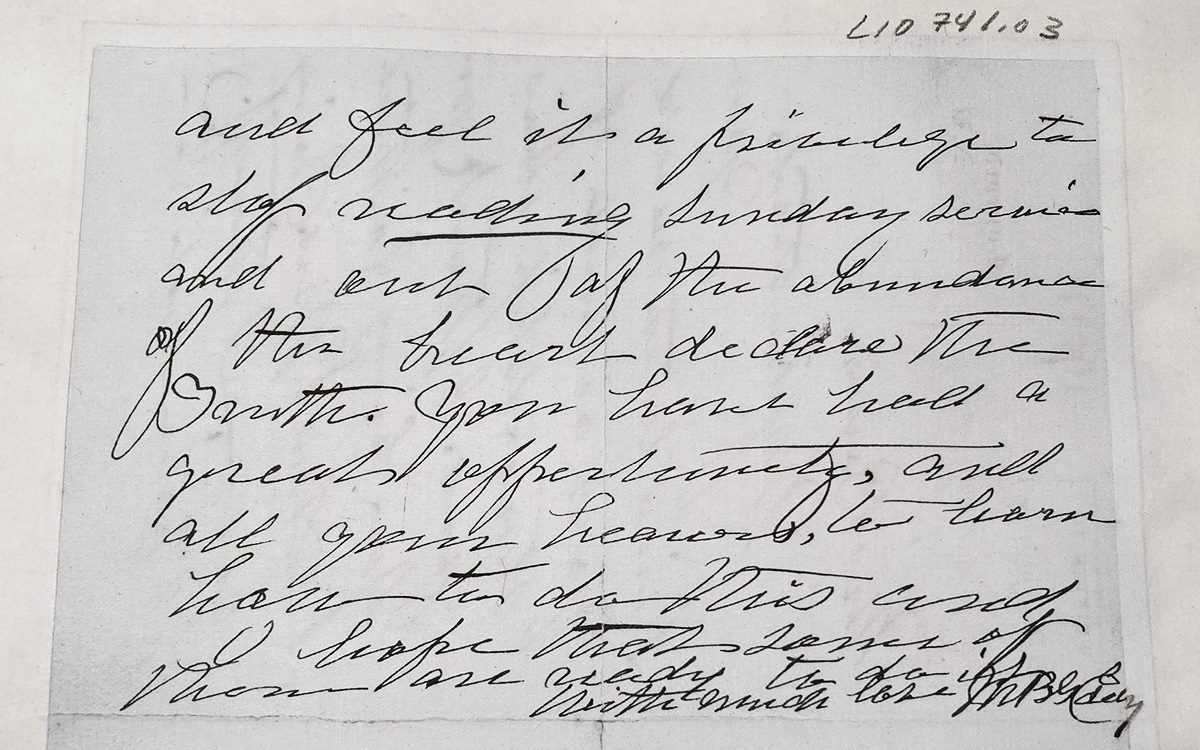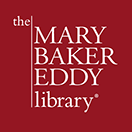Did Eddy require her students to preach without notes?

Mary Baker Eddy to Martha Harris Bogue, 1893. L10741.
Not too long ago, a Library patron quoted a paragraph from “Your Lesson-Sermons and You,” a talk given in 1960 that was printed in the Christian Science Sentinel:
Before we had the Bible Lessons, our beloved Leader, Mary Baker Eddy, when she first organized her Church, followed the customary orthodox method of church service and personal preaching. She made strong demands on her pupils; women and men were ordained to preach, some with no preparation other than their ardor, their faithfulness to the teachings of their Leader, and the inspiration they had gained from the hue of her thought. She required that they preach without notes….1
The inquirer then asked if it was really true that Mary Baker Eddy required her students to preach without notes. Some context is needed to make sense of what was going on in that regard, when Eddy “first organized her church.”2 Eddy herself preached to her church and in a few other churches in the 1870s and 1880s. The Mary Baker Eddy Papers website includes sermon notes, transcripts, and texts from this active period.3
The 1880s saw the spread of Christian Science outside New England—especially beginning in 1884, the year that Eddy taught the first Normal class of the Massachusetts Metaphysical College, which qualified graduates to teach Primary classes in the religion. Up to that time, Eddy had been the only recognized instructor. These newly-minted Christian Science teachers returned to their home cities, where they established Christian Science Institutes beginning in 1886. These were umbrellas for classes, healing work, and church services, and existed under the direction of the teacher. At the same time, churches began to form in localities without teachers and institutes.
Until 1895 the formats of Christian Science services varied from place to place. Some centered on Protestant-style preaching. Eddy’s correspondence and other historical records indicate that other services included locally compiled selections from the Bible and her book Science and Health with Key to the Scriptures, read as sermons and sometimes accompanied by members’ remarks.
This laissez-faire situation first received more structure in August 1888, when “Bible Lessons” were published in The Christian Science Journal. These were based on the interdenominational Bible study publication International Sunday School Lessons. They included notes by Frank E. Mason, Assistant Pastor of the young church (the Church of Christ [Scientist], Boston). 4
Beginning in January 1890, Christian Science Bible Lessons prepared by a committee were published in a separate periodical—the forerunner of today’s Christian Science Quarterly. The committee used the subjects and scriptural texts of the International lessons, adding citations from Science and Health. In some Christian Science branch churches, these Lessons were apparently read as the sermon. Others continued the practice of preaching.
During this evolution, Eddy’s instructions to “preach without notes” may at times have been directed (at least in part) to students who copied from her books without crediting the author. In other situations she may also have felt that the practice of reading “notes” was being used as a substitute for inspiration. In 1891 Eddy wrote to her student Laura Lathrop in New York City:
If I name the best mode of worship it will be a Pastor, a church, and this Pastor one who uses no notes but lives so near the heart of God he speaks from inspiration[.] To do this finally, you may at present have to choose your subject at home and think it thoroughly over before going into Church. I have named beginning with the Bible and Science and Health only for those who are not feeling fully equiped at first….5
Our research cannot confirm that Eddy required all her students to preach without notes. But we did find evidence that she encouraged this—and even required it—of some students. In an 1893 letter, Eddy wrote this to her student Martha Harris Bogue:
I have not requested you to give up the present mode of reading from my stores of Truth But this I do say that the time has come when you certainly, at least, some of my students —ought to be prepared and feel it a privilege to stop reading Sunday services and out of the abundance of the heart declare the Truth. You have had a great opportunity, and all your hearers, to learn how to do this and I hope that some of them are ready to do it.6
About that same time, Eddy wrote to her student Julia Field-King:
My dear student, I was greatly interested, when reading your letter, in the work you are doing. Press on. But, “bring forth things new and old” — said our Master[.] It is not best for you to commence your sermons as the First Church of Christ, Scientist, did in Chicago. It is better for you to read from the book of books the Bible then from S.&H. Read a brief paragraph which tends to elucidate and ratify your remarks. Speak without notes[.] Do not attempt to interpret so much the letter as the spirit of Christian Science. Remember this7
The opening of The Mother Church building in 1894 gained added significance when Eddy ordained the Bible and Science and Health as its pastor. Bible Lessons replaced traditional preaching. This innovation, which had been foreshadowed in some areas of the Christian Science field, became the standard for all branch churches in April 1895; The Mother Church and branch church services were now conducted by two Readers. In 1898 Eddy developed 26 Lesson-Sermon subjects. These appeared for the first time in the July–September Quarterly. The publication also continued to carry Lessons based on the International lessons, for use in instances where a second Sunday service was held. Lessons based on the International lessons were discontinued in 1899.8 Between 1893 and 1895, Eddy wrote a series of letters about preaching to her student Ruth Ewing, including this February 1894 counsel:
One thing I have longed to write to you. – It is this. Every preacher of Christian Science should speak without notes[.] “The heart must overflow If thou anothers heart wouldst reach[.]” I again admonish you to lay aside written discourses. Think beforehand, if you at first feel you must of the subject selected and note in headings its sub-divisions, lay them on the desk before you and let God give you utterance speak through you and to you and your hearers[.] Try this dear one, and take this verse for your reassurance. Trust in the Lord with all thy heart and lean not unto thine own understanding in all thy ways acknowledge Him and he will direct thy path[.] Psalms9
In March 1895, after the ordination of the Bible and Science and Health for The Mother Church, Eddy explained that she had told Ewing to speak without notes in order “to rebuke a lack of faith in divine help, and to test your humility and obedience in bearing this cross.” In the same letter, she added that we have no record that Jesus “used notes when preaching.”10 Adapted for publication in Eddy’s book Miscellaneous Writings 1883–1896, that letter indicates that the inspiration to ordain the Bible and Science and Health as pastor of The Mother Church surprised Eddy when it first came to her:
My Beloved Student: — In reply to your letter I will say: God’s ways are not as our ways; but higher far than the heavens above the earth is His wisdom above ours. When I requested you to be ordained, I little thought of the changes about to be made. When I insisted on your speaking without notes, I little knew that so soon another change in your pulpit would be demanded. But now, after His messenger has obeyed the message of divine Love, comes the interpretation thereof. But you see we both had first to obey, and to do this through faith, not sight.11
- Mary Lee Gough Nay, “Your Lesson-Sermons and You,” Christian Science Sentinel, 9 July 1960, 1224–1225. Nay had delivered this talk on June 7, at a meeting titled “Your Periodicals and You.”
- Founded in 1879, the Church of Christ (Scientist) met at a succession of locations, including Hawthorne and Chickering Halls in Boston. Eddy was ordained pastor of her church in 1881. She sometimes offered the pulpit to her students, usually those who had been Protestant clergy before embracing Christian Science. By 1886 Eddy was indicating that she hoped to appoint one of her students as pastor. See Mary Baker Eddy to Ellen Brown Linscott, 1 January 1886, L12984, https://mbepapers.org/?load=L12984. In 1889 she named Rev. Lanson P. Norcross to this role, when she left Boston and moved to New Hampshire.
- On the Papers website, it is possible to explore documents by type, including sermons. From the “Document Selection” menu, choose the category “Type,” and then take a look at documents under the “Sermon” type. You’ll also find sermon-related materials under the “Outline,” “Notes,” and “Order of Services” types as well.
- Powered by the growing Protestant Sunday School movement, the International Sunday School Lessons were the basis for youth and adult curricula across denominations.
- Eddy to Laura Lathrop, July 1891, L04345.
- Eddy to Martha Harris Bogue, 1893, L10741.
- Eddy to Julia Field-King, 29 March 1893, F00093.
- See “Development of the Quarterly” for a brief chronology.
- Eddy to Ruth Ewing, 23 February 1894, L08507. Other letters in our collection between Eddy and Ewing on this topic include the following documents: L08502, L08506, L08510, L08511, and L08512.
- Eddy to Ewing, 18 March 1895, L08514. This letter was published in the April 1895 Christian Science Journal, and later adapted and published in Eddy’s Miscellaneous Writings 1883–1896. Eddy, “Letter to a Student,” The Christian Science Journal, April 1895, 4; Eddy, “To a Student,” Miscellaneous Writings 1883-1896 (Boston: The Christian Science Board of Directors), 158–159.
- Eddy to Ewing, L08514.

